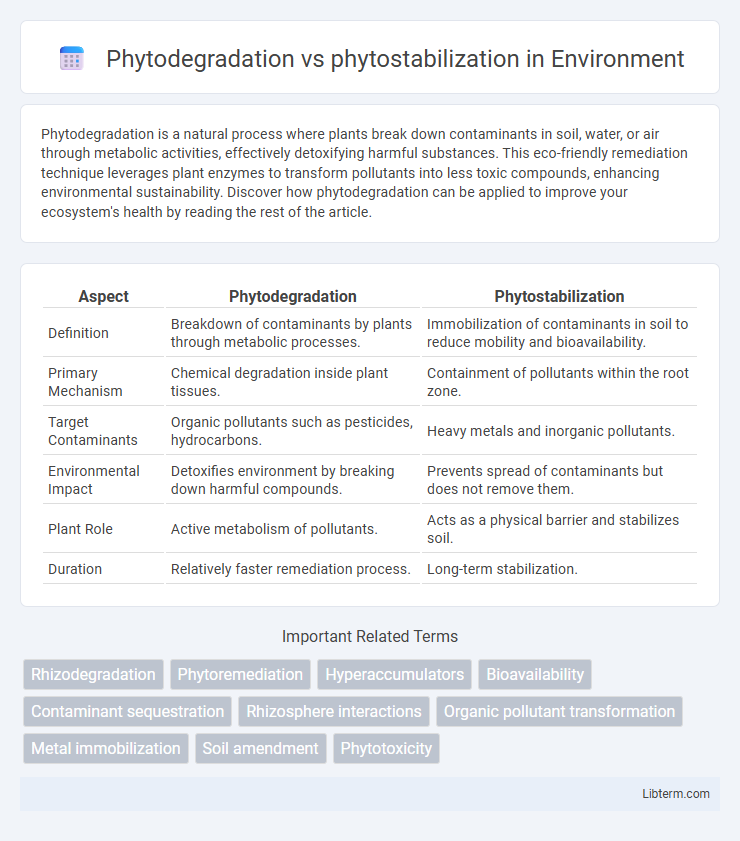Phytodegradation is a natural process where plants break down contaminants in soil, water, or air through metabolic activities, effectively detoxifying harmful substances. This eco-friendly remediation technique leverages plant enzymes to transform pollutants into less toxic compounds, enhancing environmental sustainability. Discover how phytodegradation can be applied to improve your ecosystem's health by reading the rest of the article.
Table of Comparison
| Aspect | Phytodegradation | Phytostabilization |
|---|---|---|
| Definition | Breakdown of contaminants by plants through metabolic processes. | Immobilization of contaminants in soil to reduce mobility and bioavailability. |
| Primary Mechanism | Chemical degradation inside plant tissues. | Containment of pollutants within the root zone. |
| Target Contaminants | Organic pollutants such as pesticides, hydrocarbons. | Heavy metals and inorganic pollutants. |
| Environmental Impact | Detoxifies environment by breaking down harmful compounds. | Prevents spread of contaminants but does not remove them. |
| Plant Role | Active metabolism of pollutants. | Acts as a physical barrier and stabilizes soil. |
| Duration | Relatively faster remediation process. | Long-term stabilization. |
Introduction to Phytoremediation
Phytoremediation utilizes plants to mitigate environmental contaminants through various mechanisms, including phytodegradation and phytostabilization. Phytodegradation involves plants breaking down organic pollutants into less harmful substances via metabolic processes, enhancing soil and water quality. Phytostabilization, on the other hand, immobilizes contaminants in the soil or sediments, preventing their migration and reducing bioavailability without degrading the pollutants.
What is Phytodegradation?
Phytodegradation is a process where plants absorb contaminants and break them down into less harmful substances through metabolic activities. This method is effective in treating organic pollutants such as pesticides, solvents, and petroleum hydrocarbons within the plant tissues. Phytodegradation reduces environmental toxicity by transforming pollutants into non-toxic byproducts, thereby enhancing soil and water quality.
What is Phytostabilization?
Phytostabilization is a phytoremediation technique that immobilizes contaminants in soil through plant root systems, preventing their migration and bioavailability. This method reduces the mobility of heavy metals and toxic elements by stabilizing them within the rhizosphere, minimizing environmental exposure and groundwater contamination. Unlike phytodegradation, which breaks down pollutants, phytostabilization focuses on containment and stabilization of hazardous substances in situ.
Key Mechanisms of Phytodegradation
Phytodegradation involves the breakdown of contaminants through enzymatic processes within plant tissues, particularly via oxidative enzymes such as peroxidases and laccases that transform organic pollutants into less toxic compounds. Key mechanisms include enzymatic transformation of hydrocarbons, pesticides, and industrial chemicals into simpler molecules, enhancing pollutant detoxification and removal from the environment. Phytostabilization, in contrast, immobilizes contaminants in the soil by root absorption or adsorption, preventing their migration without chemically altering the pollutants.
Key Mechanisms of Phytostabilization
Phytostabilization relies on the key mechanisms of root absorption, adsorption, and precipitation to immobilize contaminants in the soil, preventing their migration to groundwater or air. Plants enhance soil structure and microbial activity around the roots, creating a rhizosphere that promotes the transformation and stabilization of heavy metals and organic pollutants. Unlike phytodegradation, which breaks down contaminants through metabolic processes, phytostabilization focuses on containment and reduction of bioavailability to minimize environmental risks.
Advantages of Phytodegradation
Phytodegradation offers the advantage of breaking down contaminants into less toxic or harmless compounds through enzymatic activity within plant tissues, effectively reducing pollutant concentration in soil and water. This process enables the treatment of organic pollutants such as pesticides, herbicides, and industrial solvents, making it highly efficient for detoxifying environments without the need for soil excavation. Phytodegradation also promotes environmental sustainability by enhancing natural biodegradation cycles and minimizing secondary waste production compared to conventional remediation methods.
Benefits of Phytostabilization
Phytostabilization effectively immobilizes contaminants in soil, preventing their migration to groundwater or air and reducing environmental exposure. This method enhances soil structure and microbial activity, promoting ecosystem restoration while minimizing disturbance. Unlike phytodegradation, phytostabilization offers a cost-efficient and sustainable solution for managing heavy metals and persistent pollutants in contaminated sites.
Phytodegradation vs Phytostabilization: Main Differences
Phytodegradation involves the breakdown of pollutants within plant tissues through metabolic processes, effectively transforming contaminants into less harmful substances. Phytostabilization, conversely, immobilizes pollutants in the soil or root zone, preventing their migration or bioavailability without altering their chemical structure. The main difference lies in phytodegradation's active degradation of toxins versus phytostabilization's containment and stabilization strategy to reduce environmental risks.
Applications and Case Studies
Phytodegradation involves the breakdown of contaminants through plant metabolism, making it effective for organic pollutants like pesticides and explosives, as demonstrated in studies using poplar trees to remediate trichloroethylene in groundwater. Phytostabilization immobilizes heavy metals or toxic elements in soil, preventing their migration and bioavailability, with applications in mining sites where plants such as Vetiver grass stabilize lead and cadmium-contaminated soils. Case studies highlight phytodegradation's success in restoring chlorinated solvent sites, while phytostabilization is favored in areas requiring long-term containment of metals without extraction.
Choosing the Right Approach for Contaminated Sites
Phytodegradation and phytostabilization are key phytoremediation techniques used for managing contaminated sites, with phytodegradation involving the breakdown of pollutants by plants and associated microbes into less harmful compounds, while phytostabilization focuses on immobilizing contaminants in soil to prevent their spread. Selecting the right approach depends on factors such as the type and concentration of contaminants, soil characteristics, and site-specific ecological considerations, where phytodegradation is preferred for organic pollutants like pesticides and hydrocarbons, and phytostabilization suits heavy metals and persistent toxicants. Site assessment data, including contaminant bioavailability and environmental risks, guide the choice to enhance remediation efficacy and minimize ecological impact.
Phytodegradation Infographic

 libterm.com
libterm.com